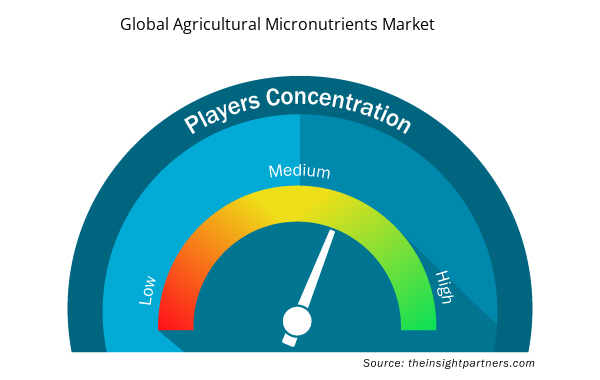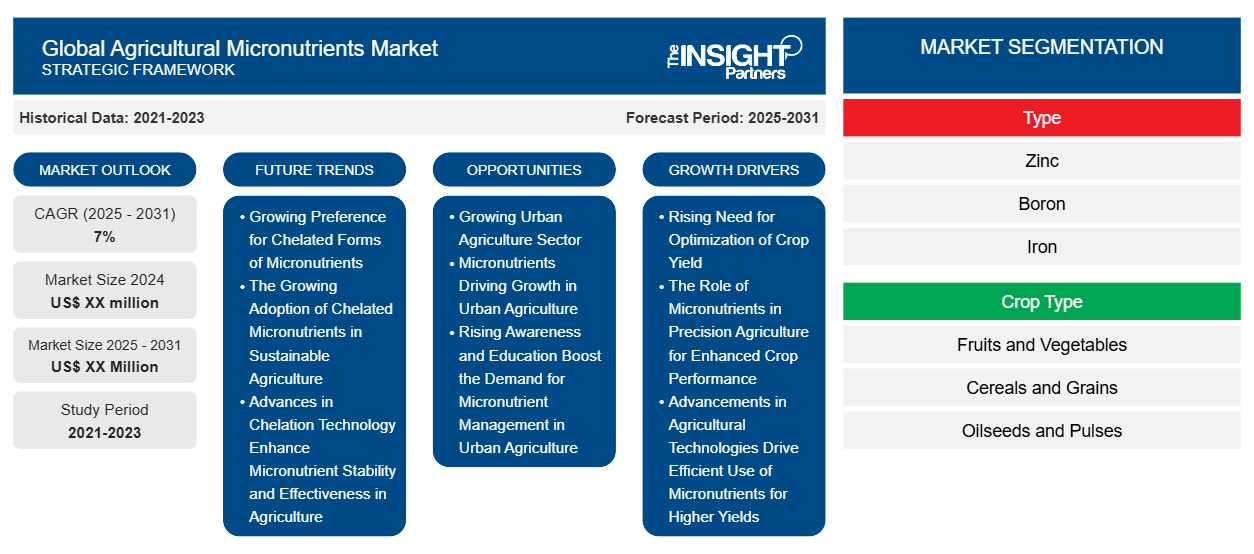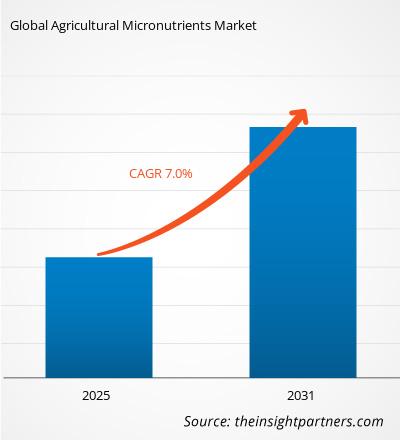Si prevede che il mercato dei micronutrienti agricoli registrerà un CAGR del 7% dal 2023 al 2031, con una dimensione di mercato in espansione da XX milioni di dollari nel 2023 a XX milioni di dollari entro il 2031.
Il report è segmentato per tipo (zinco, boro, ferro, molibdeno, rame, manganese e altri). Il report presenta inoltre un'analisi basata sul tipo di coltura (frutta e verdura, cereali e granaglie, semi oleosi e legumi e altri). In base alla forma, il report è segmentato in (chelato e non chelato). In base alla modalità di applicazione, il report è segmentato in (terreno, fogliare, fertirrigazione e altri). L'analisi globale è ulteriormente suddivisa a livello regionale e nei principali paesi. Il report offre il valore in USD per l'analisi e i segmenti di cui sopra.
Scopo del rapporto
Il report Agricultural Micronutrients Market di The Insight Partners mira a descrivere il panorama attuale e la crescita futura, i principali fattori trainanti, le sfide e le opportunità. Ciò fornirà spunti a vari stakeholder aziendali, come:
- Fornitori/produttori di tecnologia: per comprendere le dinamiche di mercato in evoluzione e conoscere le potenziali opportunità di crescita, consentendo loro di prendere decisioni strategiche informate.
- Investitori: condurre un'analisi completa delle tendenze in merito al tasso di crescita del mercato, alle proiezioni finanziarie del mercato e alle opportunità esistenti lungo la catena del valore.
- Enti di regolamentazione: regolamentano le politiche e le attività di controllo sul mercato allo scopo di ridurre al minimo gli abusi, preservare la fiducia degli investitori e sostenere l'integrità e la stabilità del mercato.
Segmentazione del mercato dei micronutrienti agricoli
Tipo
- Zinco
- Boro
- Ferro
- Molibdeno
- Rame
- Manganese
Tipo di coltura
- Frutta e verdura
- Cereali e granaglie
- Semi oleosi e legumi
Modulo
- Chelato e non chelato
Geografia
- America del Nord
- Europa
- Asia-Pacifico
- America del Sud e Centro
- Medio Oriente e Africa
Geografia
- America del Nord
- Europa
- Asia-Pacifico
- America del Sud e Centro
- Medio Oriente e Africa
Personalizza questo report in base alle tue esigenze
Riceverai la personalizzazione gratuita di qualsiasi report, comprese parti di questo report, o analisi a livello nazionale, pacchetto dati Excel, oltre a usufruire di grandi offerte e sconti per start-up e università
- Scopri le principali tendenze di mercato in questo rapporto.Questo campione GRATUITO includerà analisi di dati che spaziano dalle tendenze di mercato alle stime e alle previsioni.
Fattori trainanti della crescita del mercato dei micronutrienti agricoli
- Crescente necessità di ottimizzazione della resa delle colture: uno degli impatti enormi che saranno accordati al mercato dei micronutrienti agricoli è l'aumento dell'ottimizzazione della resa. Ciò deriverà dalla tendenza degli agricoltori a migliorare la produttività e la qualità delle colture, portando così a una maggiore domanda di micronutrienti come zinco, ferro e manganese. Questo è stato uno dei componenti critici della salute e della resa delle piante, in particolare in condizioni ambientali avverse.
- Il ruolo dei micronutrienti nell'agricoltura di precisione per migliorare le prestazioni delle colture: con la rapida crescita della popolazione, arriva la richiesta di una produzione agricola ottimizzata, insieme all'insicurezza alimentare. Per colmare le lacune delle carenze negli elementi che altrimenti limiterebbero le prestazioni delle colture, fertilizzanti e ammendanti del terreno vengono sempre più introdotti nei campi dagli agricoltori. Questa attenzione all'agricoltura di precisione accresce ulteriormente la consapevolezza del ruolo dei micronutrienti nella pratica sostenibile dell'agricoltura.
- I progressi nelle tecnologie agricole favoriscono un uso efficiente dei micronutrienti per rese più elevate: allo stesso modo, l'elevata intensità di applicazione dei micronutrienti deriva anche dalle tecnologie agricole. Con sistemi migliorati di analisi del suolo e gestione dei nutrienti, gli agricoltori sono generalmente in grado di aumentare i loro input con maggiore attenzione, non solo per rese più remunerative, ma anche per un uso più economico delle risorse per garantire una maggiore redditività nelle operazioni agricole.
Tendenze future del mercato dei micronutrienti agricoli
- Crescente preferenza per forme chelate di micronutrienti: una delle nuove tendenze nei micronutrienti agricoli è la crescente domanda di forme chelate di micronutrienti. I micronutrienti chelati sono micronutrienti chelati a molecole organiche, che offrono una maggiore biodisponibilità rispetto alle forme tradizionali e, quindi, un maggiore assorbimento da parte delle piante e migliori prestazioni delle colture.
- La crescente adozione di micronutrienti chelati nell'agricoltura sostenibile: un altro vantaggio delle applicazioni di micronutrienti chelati segnalato dalla scoperta degli agricoltori è la loro correzione mirata di specifiche carenze di nutrienti nei terreni. Man mano che la consapevolezza ambientale risvegliata verso la gestione dei nutrienti aumenta, queste forme vengono facilmente adottate come modalità per un numero sempre maggiore di agricoltori per migliorare la salute e la resa delle piante. Questa tendenza concorda con l'appello rivolto a tutte le nazioni del mondo ad adottare un'agricoltura sostenibile.
- I progressi nella tecnologia di chelazione migliorano la stabilità e l'efficacia dei micronutrienti in agricoltura: progressi nella tecnologia di chelazione da altri fattori. Realizzazione di ulteriori miglioramenti nel modo in cui i micronutrienti chelati sono formulati per ottenere maggiore stabilità e, quindi, efficacia. Tali nuove formulazioni di micronutrienti chelati ne facilitano l'applicazione e quindi forniscono risultati migliori, un esempio che impone un assorbimento più ampio e sistemico nei settori agricoli.
Opportunità di mercato dei micronutrienti agricoli
- Settore agricolo urbano in crescita: in effetti, il settore agricolo urbano in crescita è una fonte di crescita molto considerevole per il mercato dei micronutrienti agricoli. Poiché la dipendenza dalla coltivazione di cibo all'interno delle città avanza come un modo essenziale per soddisfare la domanda di cibo, la gestione dei nutrienti è sempre più importante. I micronutrienti svolgono un ruolo fondamentale nell'incrementare la produttività di questi sistemi agricoli compatti.
- Micronutrienti che guidano la crescita nell'agricoltura urbana: nuove idee in quest'area sono l'agricoltura verticale e l'idroponica; queste non possono funzionare senza nutrienti formulati con precisione. Sono i micronutrienti che massimizzeranno la crescita delle piante in ambienti controllati, come nell'agricoltura urbana. Gli agricoltori urbani usano questi micronutrienti per ottenere rese più elevate in spazi piccoli e angusti. Questi prodotti a base di micronutrienti stanno diventando sempre più ricercati per essere utilizzati in contesti agricoli urbani.
- La crescente consapevolezza e istruzione aumentano la domanda di gestione dei micronutrienti nell'agricoltura urbana: una maggiore consapevolezza pubblica riguardo ai programmi educativi e alla formazione nelle città crea anche una maggiore domanda di consapevolezza sulla gestione dei nutrienti. L'aumento della consapevolezza dei benefici dei micronutrienti nell'agricoltura urbana si aggiunge ulteriormente alla tendenza crescente di tali prodotti. Ciò continuerà, quindi, a far crescere il mercato dei micronutrienti agricoli man mano che la tendenza dell'agricoltura urbana continua a crescere.
Approfondimenti regionali sul mercato globale dei micronutrienti agricoli
Le tendenze regionali e i fattori che influenzano il mercato globale dei micronutrienti agricoli durante il periodo di previsione sono stati ampiamente spiegati dagli analisti di Insight Partners. Questa sezione discute anche i segmenti e la geografia del mercato globale dei micronutrienti agricoli in Nord America, Europa, Asia Pacifico, Medio Oriente e Africa e America meridionale e centrale.

- Ottieni i dati specifici regionali per il mercato globale dei micronutrienti agricoli
Ambito del rapporto sul mercato globale dei micronutrienti agricoli
| Attributo del report | Dettagli |
|---|---|
| Dimensioni del mercato nel 2023 | XX milioni di dollari USA |
| Dimensioni del mercato entro il 2031 | XX milioni di dollari USA |
| CAGR globale (2023-2031) | 7% |
| Dati storici | 2021-2022 |
| Periodo di previsione | 2024-2031 |
| Segmenti coperti | Per tipo
|
| Regioni e Paesi coperti | America del Nord
|
| Leader di mercato e profili aziendali chiave |
|
Densità degli attori del mercato globale dei micronutrienti agricoli: comprendere il suo impatto sulle dinamiche aziendali
Il mercato globale dei micronutrienti agricoli sta crescendo rapidamente, spinto dalla crescente domanda degli utenti finali dovuta a fattori quali l'evoluzione delle preferenze dei consumatori, i progressi tecnologici e una maggiore consapevolezza dei benefici del prodotto. Con l'aumento della domanda, le aziende stanno ampliando le loro offerte, innovando per soddisfare le esigenze dei consumatori e capitalizzando sulle tendenze emergenti, il che alimenta ulteriormente la crescita del mercato.
La densità degli operatori di mercato si riferisce alla distribuzione di aziende o società che operano in un particolare mercato o settore. Indica quanti concorrenti (operatori di mercato) sono presenti in un dato spazio di mercato in relazione alle sue dimensioni o al valore di mercato totale.
Le principali aziende che operano nel mercato globale dei micronutrienti agricoli sono:
- BASF SE
- Coromandel International Limited
- Nutrien Ltd.
- La Compagnia del Mosaico
- Gruppo Haifa
Disclaimer : le aziende elencate sopra non sono classificate secondo un ordine particolare.

- Ottieni una panoramica dei principali attori del mercato globale dei micronutrienti agricoli
Punti di forza chiave
- Copertura completa: il rapporto copre in modo completo l'analisi di prodotti, servizi, tipologie e utenti finali del mercato dei micronutrienti agricoli, fornendo una panoramica olistica.
- Analisi degli esperti: il rapporto è compilato sulla base della conoscenza approfondita di esperti e analisti del settore.
- Informazioni aggiornate: il rapporto garantisce la pertinenza aziendale grazie alla copertura di informazioni recenti e tendenze nei dati.
- Opzioni di personalizzazione: questo report può essere personalizzato per soddisfare le esigenze specifiche del cliente e adattarsi in modo appropriato alle strategie aziendali.
Il rapporto di ricerca sul mercato dei micronutrienti agricoli può, quindi, aiutare a guidare il percorso di decodificazione e comprensione dello scenario del settore e delle prospettive di crescita. Sebbene possano esserci alcune preoccupazioni valide, i vantaggi complessivi di questo rapporto tendono a superare gli svantaggi.
- Analisi storica (2 anni), anno base, previsione (7 anni) con CAGR
- Analisi PEST e SWOT
- Valore/volume delle dimensioni del mercato - Globale, regionale, nazionale
- Industria e panorama competitivo
- Set di dati Excel



Report Coverage
Revenue forecast, Company Analysis, Industry landscape, Growth factors, and Trends

Segment Covered
This text is related
to segments covered.

Regional Scope
North America, Europe, Asia Pacific, Middle East & Africa, South & Central America

Country Scope
This text is related
to country scope.
Domande frequenti
Growing Preference for Chelated Forms of Micronutrients is expected to be the key market trends.
Based on geography, Asia Pacific held the largest share of the agricultural micronutrients market.
Based on type, zinc, is expected to witness the fastest growth during the forecast period
BASF SE, Coromandel International Limited, Nutrien Ltd are some of the key players operating in the agricultural micronutrients market
Rising Need for Optimization of Crop Yield is driving the market growth
The Agricultural Micronutrients Market is estimated to witness a CAGR of 7% from 2023 to 2031
Trends and growth analysis reports related to Chemicals and Materials : READ MORE..
The List of Companies
1. BASF SE
2. Coromandel International Limited
3. Nutrien Ltd.
4. The Mosaic Company
5. Haifa Group
6. Yara International ASA
7. Helena Agri-Enterprises LLC
8. Valagro S.p.A
9. Sigma AgriScience, LLC
10. Aries Agro Limited
11. Nufarm Limited
12. AgroLiquid
13. Agrium
14. Akzonobel
15. Dow Chemical
16. ADAMA Agricultural Solutions Ltd.
17. Agrium Inc.
18. Akzo Nobel N.V.
19. Auriga Industries A/S
20.Bayer Crop.
The Insight Partners performs research in 4 major stages: Data Collection & Secondary Research, Primary Research, Data Analysis and Data Triangulation & Final Review.
- Data Collection and Secondary Research:
As a market research and consulting firm operating from a decade, we have published and advised several client across the globe. First step for any study will start with an assessment of currently available data and insights from existing reports. Further, historical and current market information is collected from Investor Presentations, Annual Reports, SEC Filings, etc., and other information related to company’s performance and market positioning are gathered from Paid Databases (Factiva, Hoovers, and Reuters) and various other publications available in public domain.
Several associations trade associates, technical forums, institutes, societies and organization are accessed to gain technical as well as market related insights through their publications such as research papers, blogs and press releases related to the studies are referred to get cues about the market. Further, white papers, journals, magazines, and other news articles published in last 3 years are scrutinized and analyzed to understand the current market trends.
- Primary Research:
The primarily interview analysis comprise of data obtained from industry participants interview and answers to survey questions gathered by in-house primary team.
For primary research, interviews are conducted with industry experts/CEOs/Marketing Managers/VPs/Subject Matter Experts from both demand and supply side to get a 360-degree view of the market. The primary team conducts several interviews based on the complexity of the markets to understand the various market trends and dynamics which makes research more credible and precise.
A typical research interview fulfils the following functions:
- Provides first-hand information on the market size, market trends, growth trends, competitive landscape, and outlook
- Validates and strengthens in-house secondary research findings
- Develops the analysis team’s expertise and market understanding
Primary research involves email interactions and telephone interviews for each market, category, segment, and sub-segment across geographies. The participants who typically take part in such a process include, but are not limited to:
- Industry participants: VPs, business development managers, market intelligence managers and national sales managers
- Outside experts: Valuation experts, research analysts and key opinion leaders specializing in the electronics and semiconductor industry.
Below is the breakup of our primary respondents by company, designation, and region:

Once we receive the confirmation from primary research sources or primary respondents, we finalize the base year market estimation and forecast the data as per the macroeconomic and microeconomic factors assessed during data collection.
- Data Analysis:
Once data is validated through both secondary as well as primary respondents, we finalize the market estimations by hypothesis formulation and factor analysis at regional and country level.
- Macro-Economic Factor Analysis:
We analyse macroeconomic indicators such the gross domestic product (GDP), increase in the demand for goods and services across industries, technological advancement, regional economic growth, governmental policies, the influence of COVID-19, PEST analysis, and other aspects. This analysis aids in setting benchmarks for various nations/regions and approximating market splits. Additionally, the general trend of the aforementioned components aid in determining the market's development possibilities.
- Country Level Data:
Various factors that are especially aligned to the country are taken into account to determine the market size for a certain area and country, including the presence of vendors, such as headquarters and offices, the country's GDP, demand patterns, and industry growth. To comprehend the market dynamics for the nation, a number of growth variables, inhibitors, application areas, and current market trends are researched. The aforementioned elements aid in determining the country's overall market's growth potential.
- Company Profile:
The “Table of Contents” is formulated by listing and analyzing more than 25 - 30 companies operating in the market ecosystem across geographies. However, we profile only 10 companies as a standard practice in our syndicate reports. These 10 companies comprise leading, emerging, and regional players. Nonetheless, our analysis is not restricted to the 10 listed companies, we also analyze other companies present in the market to develop a holistic view and understand the prevailing trends. The “Company Profiles” section in the report covers key facts, business description, products & services, financial information, SWOT analysis, and key developments. The financial information presented is extracted from the annual reports and official documents of the publicly listed companies. Upon collecting the information for the sections of respective companies, we verify them via various primary sources and then compile the data in respective company profiles. The company level information helps us in deriving the base number as well as in forecasting the market size.
- Developing Base Number:
Aggregation of sales statistics (2020-2022) and macro-economic factor, and other secondary and primary research insights are utilized to arrive at base number and related market shares for 2022. The data gaps are identified in this step and relevant market data is analyzed, collected from paid primary interviews or databases. On finalizing the base year market size, forecasts are developed on the basis of macro-economic, industry and market growth factors and company level analysis.
- Data Triangulation and Final Review:
The market findings and base year market size calculations are validated from supply as well as demand side. Demand side validations are based on macro-economic factor analysis and benchmarks for respective regions and countries. In case of supply side validations, revenues of major companies are estimated (in case not available) based on industry benchmark, approximate number of employees, product portfolio, and primary interviews revenues are gathered. Further revenue from target product/service segment is assessed to avoid overshooting of market statistics. In case of heavy deviations between supply and demand side values, all thes steps are repeated to achieve synchronization.
We follow an iterative model, wherein we share our research findings with Subject Matter Experts (SME’s) and Key Opinion Leaders (KOLs) until consensus view of the market is not formulated – this model negates any drastic deviation in the opinions of experts. Only validated and universally acceptable research findings are quoted in our reports.
We have important check points that we use to validate our research findings – which we call – data triangulation, where we validate the information, we generate from secondary sources with primary interviews and then we re-validate with our internal data bases and Subject matter experts. This comprehensive model enables us to deliver high quality, reliable data in shortest possible time.


 Ottieni un campione gratuito per questo repot
Ottieni un campione gratuito per questo repot